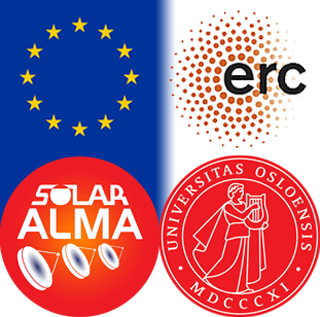Introduction - The chromospheric/coronal heating problem

The layers above the visible "surface" of our Sun (also referred to as the solar atmosphere) consists of - from the solar “surface” outwards - the photosphere (from where most of the visible light originates), the chromosphere, the narrow transition region, and the corona, which is prominently visible during the solar eclipses. The gas temperature drops slightly with height from 5500o C at the surface before, counter-intuitively, rising in the chromosphere above and eventually jumping to values of a few millions of degrees C in the outermost layers (see the image to the right). Obviously, the outer layers are heated by physical processes, which provide and dissipate energy - a fact known since the late 1930s. Despite many attempts to solve this so-called coronal heating problem during the last decades, it remains one of the large open questions in contemporary solar physics. The same is true for the chromosphere, which is denser than the corona, and thus requires a larger heating rate, beside the fact that both layers are coupled in many ways. The source of high temperatures in the outer layers and corresponding emission of radiation is a general question for stars.
About the SolarALMA project
The key question of the SolarALMA project was how are the outer layers of the Sun heated to such high temperatures. A large number of heating mechanisms have been proposed as explanation but it remains open by which mechanisms are most important. The key to solving the chromospheric/coronal heating problem lies in accurate observations at high spatial, temporal and spectral resolution, facilitating the identification of the mechanisms responsible for the transport and dissipation of energy. This has so far been impeded by the small number of accessible diagnostics and the challenges with their interpretation. The interferometric Atacama Large Millimeter/submillimeter Array (ALMA), located at an altitude of 5000m in the Chilean Andes, now offers impressive capabilities. Due to the properties of the solar radiation at millimeter wavelengths, ALMA serves as a linear thermometer, mapping narrow layers at different heights. It can measure the thermal structure and dynamics of the solar chromosphere and thus sources and sinks of atmospheric heating. Radio recombination and molecular lines (e.g., CO) potentially provide complementary kinetic and thermal diagnostics, while the polarisation of the continuum intensity and the Zeeman effect can be exploited for valuable chromospheric magnetic field measurements. The first regular observations of the Sun with ALMA have been carried out in December 2016, among them were solar observations in connection with this project.
The aim of the SolarALMA project was to develop the necessary diagnostic tools and use them for solar observations with ALMA. The preparation, optimisation and interpretation of these observations was supported by state-of-the-art numerical simulations. A key objective was the identification of the dominant physical processes and their contributions to the transport and dissipation of energy. The results promise to be a significant step towards solving the coronal heating problem with general implications for stellar activity.
(Click here for the official abstract of the ERC project.)
Main results
As a result of the SolarALMA project, the small-scale structure and dynamics of the solar atmosphere was addressed with the help of new ALMA observations in several scientific publications. Particular focus was on oscillations and propagating waves, which are primary contributors to the energy transport and heating in the solar chromosphere.
In order to reach these research goals, the Solar ALMA Pipeline (SoAP) was developed. SoAP generates science-ready time series of ALMA images of the Sun based on the calibrated data delivered by ALMA. As a final result, the SolarALMA project published the Solar ALMA Science Archive (SALSA) and the Solar ALMA Library of Auxiliary Tools (SALAT), which provide easy access to science-ready data for the research community.
The research team
Next to the PI (Sven Wedemeyer), the core team of the SolarALMA project consisted of 3 (post-doctoral) researchers and 2 PhD students, supported by a RoCS Research Software Engineer (Mikolaj Szydlarski). The team collaborates closely with the EMISSA project team (1 post-doc and 1 PhD), with the colleagues at RoCS and the international Solar Simulations for the Atacama Large Millimeter Observatory Network (SSALMON), which are all hosted at the Institute of Theoretical Astrophysics, University of Oslo. Among our many international collaboration partners is the international solar ALMA development team.
Active core team members |
|
 |
(Associate Professor, project leader) |
 |
(Research Software Engineer, RoCS) |
 |
(Researcher) |
 |
Henrik Eklund (PhD fellow) |
 |
Juan Camilo Guevara Gomez (PhD fellow) |
 |
Vasco Manuel de Jorge Henriques (Researcher) |
 |
(Post-doctoral Research Fellow) |
|
Associated team members (EMISSA project) |
|
 |
Atul Mohan (Post-doctoral research fellow) |
 |
Sneha Pandit (PhD fellow) |
|
Previous team members |
|
 |
Daniel Jakobsson (MSc, 1-6/2020; Researcher, Rosseland Visitor Program, 6-12/2020) |
 |
Caitlin Gilchrist-Millar (IAESTE trainee, 8-9/2017) |
 |
Andrew Rodger (PhD student, University of Glasgow, at ITA: 1-5/2017) |
 |
Daniel Wass (Post-graduate trainee, IAESTE, 11-12/2016) |
Master thesis projects
Master thesis projects can be offered as part of the SolarALMA project. Click here for more information and possible thesis projects.





